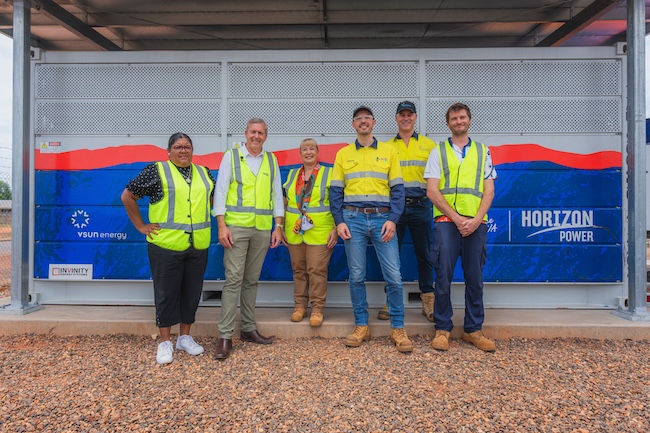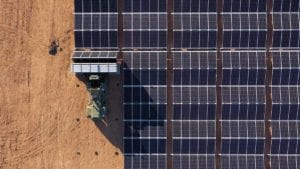A deep-storage battery being trialled in Kununurra in the Kimberley region of Western Australia could solve the clean energy challenge for some of the nation’s most remote communities.
As well as being a challenging environment to live or work in, hot and humid Kununurra is not connected to the state or national electricity grid.
“A lot of our communities are remote and do struggle with the cost of living and we don’t want them to miss out on the energy transition,” Horizon Power’s executive general manager for business development and strategy Vi Garrood told AAP.
“And we don’t want to compromise on safety – that’s why small-scale trials are really important,” she said.
The vanadium flow battery won’t power cars, laptops or fit into a mobile phone, but it can store energy for 10-12 hours and help homes and worksites to displace diesel and gas with clean, safe and reliable power.
As the state’s regional power provider, Horizon is using the trial to learn how to provide safe, affordable, reliable off-grid power during extreme temperatures and major weather events.
“It’s one of the technologies we need to get us to net zero and running on 100 per cent renewables for periods of time,” Ms Garrood said.
After stress-testing the technology in Kununurra, it could be rolled out across Horizon’s microgrids and other systems.
“Each battery design is examined on the basis of what application we need it for – so what is the problem it’s solving,” she said.
With a 78-kilowatt capacity and 220 kilowatt hours of storage, WA Energy Minister Reece Whitby says the vanadium battery is well suited to Kimberley conditions, where energy storage must cope with extreme temperatures and deliver energy over a long period of time.
“Here in Kununurra, where it was 44 degrees the other day, you need a battery that’s tough … and these, we hope, will do the job very well,” Mr Whitby said.
“We know that the sun doesn’t always shine and the wind doesn’t always blow so batteries are the answer in terms of capturing that energy when it’s available and dispatching it when it’s really needed.
Horizon is also trialling Redflow’s zinc bromine flow battery (100 kW/400 kWh) on Nullagine’s microgrid and BASF’s sodium sulphur battery (250 kW/1450 kWh) at Carnarvon.
“The eyes of the energy world are looking at Kununurra to see how this goes.”
The various technologies can shift rooftop solar electricity produced in the middle of the day to evening hours and operate alongside existing lithium-ion batteries in Horizon’s network, to provide longer-duration storage.
Most of Horizon’s systems are microgrids, for remote communities and mining operations, and involve generation, network and retail components all within the particular community they are supporting.
Ms Garrood said deep-storage batteries can cover periods of “renewable drought” when there is minimal generation, including for night-time loads.
“Long-duration energy storage is important for us because it’s predicted to be cost-effective when compared to lithium-ion batteries,” she said.
“It could open the door to taking our small, microgrid communities to 100 per cent renewable energy – that’s the plan.”
“Our best chance of success at decarbonisation is to throw everything at it, and deep storage is one of many solutions in our toolkit,” she said.
As the technology is based around a tank of liquid electrolytes, they are less likely to catch fire. They can be scaled up and save space by adding more tanks rather than shipping in container-sized lithium batteries.
It’s also very important to have local support and gain experience when trialling new technology, especially for systems that are in remote locations and typically automated, Ms Garrood said.
The technology supplied by VSUN Energy, an offshoot of mining company Australian Vanadium Ltd (AVL), can charge and discharge energy at the same time and the units have a life span of more than 25 years.
With most of the world’s vanadium supply coming from Russia, China, and South Africa, AVL intends to provide an ethical supply of vanadium to battery, steel and metals markets.
Their electrolyte manufacturing facility in WA is part of a “pit to battery” strategy that could support the rollout of vanadium flow batteries in Australia, according to chief executive Graham Arvidson.
While it’s a first for Horizon, the 40-year-old technology was invented in Australia at the University of NSW and has been grid-connected for 20 years in other countries.
“It’s really coming into its own with the energy transition because we’re looking at long-duration batteries to enable renewable energy like solar to be shifted from day to evening,” Mr Arvidson.
“Now that this battery is commissioned, we’re looking forward to a true test of what it can do for communities like Kununurra,” he said.








